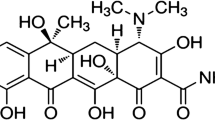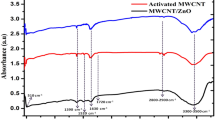Abstract
Nanostructured carbon material (NSCM) based chemiresistive sensors are popular for sensing different analytes because of their high sensitivity, low cost, and simple construction compared with the conventional sensors. In this paper, the carbon strand (bulk) containing carbon nanostructured materials is fabricated through high-density polyethylene (HDPE). HDPE has been used as a carbon source and carbon strand is grown by pulsed arc discharge method between two hollow metallic rods in the presence of the HDPE. Later on, these electrodes have been used as contacts in the proposed structure. The analyzed structure as a quasi-metallic multi-walled carbon nanotube (MWCNT) based chemiresistive sensor is considered for electrochemical sensing of amoxicillin, penicillin-G, and ampicillin antibiotics. Therefore, the MWCNT quantum conductance as a modeling platform is employed. Finally, current-voltage (I-V) characteristics of samples are investigated in the presence of antibiotic materials for different conditions. To this end, the proposed model is compared with experimental data and favorable agreement is reported.





Similar content being viewed by others
References
Balarak D, Mostafapour F, Bazrafshan E, Saleh TA (2017) Studies on the adsorption of amoxicillin on multi-wall carbon nanotubes. Water Sci Technol 75:1599–1606
Kumar AS, Sornambikai S, Deepika L, Zen J-M (2010) Highly selective immobilization of amoxicillin antibiotic on carbon nanotube modified electrodes and its antibacterial activity. J Mater Chem 20:10152–10158
Zervosen A, Sauvage E, Frère J-M, Charlier P, Luxen A (2012) Development of new drugs for an old target—the penicillin binding proteins. Molecules 17:12478–12505
Mehrani MJ, Tashayoei MR, Ferdowsi A, Hashemi H (2016) Qualitative evaluation of antibiotics in WWTP and review of some antibiotics removal methods. Int Acad J Sci Eng 3:11–22
Ji L, Chen W, Bi J, Zheng S, Xu Z, Zhu D, Alvarez PJ (2010) Adsorption of tetracycline on single-walled and multi-walled carbon nanotubes as affected by aqueous solution chemistry. Environ Toxicol Chem 29:2713–2719
Mohammadi A, Kazemipour M, Ranjbar H, Walker RB, Ansari M (2015) Amoxicillin removal from aqueous media using multi-walled carbon nanotubes. Fullerenes, Nanotubes, Carbon Nanostruct 23:165–169
Diekema DJ, Pfaller MA (2013) Rapid detection of antibiotic-resistant organism carriage for infection prevention. Clin Infect Dis 56:1614–1620
Zhou L, Li D-J, Gai L, Wang J-P, Li Y-B (2012) Electrochemical aptasensor for the detection of tetracycline with multi-walled carbon nanotubes amplification. Sensors Actuators B Chem 162:201–208
Yola ML, Eren T, Atar N (2014) Molecularly imprinted electrochemical biosensor based on Fe@ Au nanoparticles involved in 2-aminoethanethiol functionalized multi-walled carbon nanotubes for sensitive determination of cefexime in human plasma. Biosens Bioelectron 60:277–285
Moraes FC, Silva TA, Cesarino I, Lanza MR, Machado SA (2013) Antibiotic detection in urine using electrochemical sensors based on vertically aligned carbon nanotubes. Electroanalysis 25:2092–2099
Chen B, Ma M, Su X (2010) An amperometric penicillin biosensor with enhanced sensitivity based on co-immobilization of carbon nanotubes, hematein, and β-lactamase on glassy carbon electrode. Anal Chim Acta 674:89–95
Lan L, Yao Y, Ping J, Ying Y (2017) Recent advances in nanomaterial-based biosensors for antibiotics detection. Biosens Bioelectron 91:504–514
Perez-Lopez B, Merkoci A (2012) Carbon nanotubes and graphene in analytical sciences. Microchim Acta 179:1–16
Cesarino I, Moraes FC, Machado SA (2011) A biosensor based on polyaniline-carbon nanotube core-shell for electrochemical detection of pesticides. Electroanalysis 23:2586–2593
Kim SN, Rusling JF, Papadimitrakopoulos F (2007) Carbon nanotubes for electronic and electrochemical detection of biomolecules. Adv Mater 19:3214–3228
Ramnani P, Saucedo NM, Mulchandani A (2016) Carbon nanomaterial-based electrochemical biosensors for label-free sensing of environmental pollutants. Chemosphere 143:85–98
Leyden MR, Schuman C, Sharf T, Kevek J, Remcho VT, Minot ED (2010) Fabrication and characterization of carbon nanotube field-effect transistor biosensors. In: Shinar R, Kymissis I (eds) Organic semiconductors in sensors and bioelectronics III, vol 7779. San Diego, Calif, USA
Allen BL, Kichambare PD, Star A (2007) Carbon nanotube field-effect-transistor-based biosensors. Adv Mater 19:1439–1451
Absalan G, Akhond M, Ershadifar H (2015) Highly sensitive determination and selective immobilization of amoxicillin using carbon ionic liquid electrode. J Solid State Electrochem 19:2491–2499
Ferraz BR, Leite FR, Malagutti AR (2016) Highly sensitive electrocatalytic determination of pyrazinamide using a modified poly (glycine) glassy carbon electrode by square-wave voltammetry. J Solid State Electrochem 20:2509–2516
Shahrokhian S, Hosseini-Nassab N, Kamalzadeh Z (2014) Fabrication of an electrochemical sensor based on the electrodeposition of Pt nanoparticles on multiwalled carbon nanotubes film for voltammetric determination of ceftriaxone in the presence of lidocaine, assisted by factorial-based response-surface methodology. J Solid State Electrochem 18:77–88
Majdi S, Jabbari A, Heli H, Yadegari H, Moosavi-Movahedi A, Haghgoo S (2009) Electrochemical oxidation and determination of ceftriaxone on a glassy carbon and carbon-nanotube-modified glassy carbon electrodes. J Solid State Electrochem 13:407–416
Hasanpour F, Ensafi AA, Khayamian T (2010) Simultaneous chemiluminescence determination of amoxicillin and clavulanic acid using least squares support vector regression. Anal Chim Acta 670:44–50
Tang R, Shi Y, Hou Z, Wei L (2017) Carbon nanotube-based chemiresistive sensors. Sensors 17:882
Sahihazar MM, Nouri M, Rahmani M, Ahmadi MT, Kasani H (2018) Fabrication of carbon nanoparticle strand under pulsed arc discharge. Plasmonics 13:2377–2386
Nouri M, Meshginqalam B, Sahihazar MM, Dizaji RSP, Ahmadi MT, Ismail R (2018) Experimental and theoretical investigation of sensing parameters in carbon nanotube-based DNA sensor. IET Nanobiotechnol 12:1125–1129
Kasani H, Khodabakhsh R, Ahmadi MT, Ochbelagh DR, Ismail R (2017) Electrical properties of MWCNT/HDPE composite-based MSM structure under neutron irradiation. J Electron Mater 46:2548–2555
Kasani H, Taghi Ahmadi M, Khoda-Bakhsh R, RezaeiOchbelagh D, Ismail R (2016) Influences of Sr-90 beta-ray irradiation on electrical characteristics of carbon nanoparticles. J Appl Phys 119:124510
Helbling T, Hierold C, Durrer L, Roman C, Pohle R, Fleischer M (2008) Suspended and non-suspended carbon nanotube transistors for NO2 sensing–a qualitative comparison. Phys Status Solidi B 245:2326–2330
Abadi HKF, Ahmadi M, Yusof R, Saeidmanesh M, Rahmani M, Kiani MJ, Ghadiry M (2014) Development of carbon nanotube based biosensors model for detection of single-nucleotide polymorphism. Sci Adv Mater 6:513–519
Nshimiyimana JP, Zhang J, Hu X, Chi X, Wu P, Liu S, Zhang Z, Chu W, Sun L (2017) Controlling conducting channels of single-walled carbon nanotube array with atomic force microscopy. Appl Nanosci 7:759–764
Wang F, Swager TM (2011) Diverse chemiresistors based upon covalently modified multiwalled carbon nanotubes. J Am Chem Soc 133:11181–11193
Wong H-SP, Akinwande D (2011) Carbon nanotube and graphene device physics. Cambridge University Press, Cambridge
Imam S-A, Kalam N, Abdhullah S (2014) Temperature dependence of carbon nanotube field effect transistor under non-ballistic conduction considering different dielectric materials. Nanosci Nanotechnol 4:52–58
Biercuk MJ, Ilani S, Marcus CM, McEuen PL (2007) Electrical transport in single-wall carbon nanotubes. In: Carbon nanotubes, vol 111. Springer, pp 455-493
Naeemi A, Meindl JD (2006) Compact physical models for multiwall carbon-nanotube interconnects. IEEE Electron Device Lett 27:338–340
Naeemi A, Meindl JD (2008) Performance modeling for single-and multiwall carbon nanotubes as signal and power interconnects in gigascale systems. IEEE Trans Electron Devices 55:2574–2582
Naeemi A, Meindl JD (2007) Physical modeling of temperature coefficient of resistance for single-and multi-wall carbon nanotube interconnects. IEEE Electron Device Lett 28:135–138
Naeemi A, Meindl JD (2005) Impact of electron-phonon scattering on the performance of carbon nanotube interconnects for GSI. IEEE Electron Device Lett 26:476–478
Urbina A, Echeverria I, Pérez-Garrido A, Díaz-Sánchez A, Abellán J (2003) Quantum conductance steps in solutions of multiwalled carbon nanotubes. Phys Rev Lett 90:106603
Datta S (1997) Electronic transport in mesoscopic systems. Cambridge University Press, Cambridge
Bushmaker AW, Oklejas V, Walker D, Hopkins AR, Chen J, Cronin SB (2016) Single-ion adsorption and switching in carbon nanotubes. Nat Commun 7:10475
Jarillo-Herrero PD (2005) Quantum transport in carbon nanotubes. Ph.D. thesis, TU Delft, Delft
Grujicic M, Cao G, Singh R (2003) The effect of topological defects and oxygen adsorption on the electronic transport properties of single-walled carbon-nanotubes. Appl Surf Sci 211:166–183
Takane Y, Wakabayashi K (2003) Random-matrix approach to quantum electron transport in metallic carbon nanotubes. J Phys Soc Jpn 72:2710–2713
Das MP (2010) Mesoscopic systems in the quantum realm: fundamental science and applications. Adv Nat Sci Nanosci Nanotechnol 1:043001
Close GF, Wong H-SP (2008) Assembly and electrical characterization of multiwall carbon nanotube interconnects. IEEE Trans Nanotechnol 7:596–600
Baughman RH, Zakhidov AA, De Heer WA (2002) Carbon nanotubes—the route toward applications. science 297:787–792
Li HJ, Lu W, Li J, Bai X, Gu C (2005) Multichannel ballistic transport in multiwall carbon nanotubes. Phys Rev Lett 95:086601
Chimowa G, Linganiso EC, Churochkin D, Coville NJ, Bhattacharyya S (2011) Origin of conductivity crossover in entangled multiwalled carbon nanotube networks filled by iron. Phys Rev B 84:205429
Acknowledgments
The authors thank Miss Elnaz Khoramak and Mr. Reza Alizadeh at the Urmia University for their technical support.
Author information
Authors and Affiliations
Corresponding author
Additional information
Publisher’s note
Springer Nature remains neutral with regard to jurisdictional claims in published maps and institutional affiliations.
Rights and permissions
About this article
Cite this article
Moutab Sahihazar, M., Ahmadi, M.T., Nouri, M. et al. Quantum conductance investigation on carbon nanotube–based antibiotic sensor. J Solid State Electrochem 23, 1641–1650 (2019). https://doi.org/10.1007/s10008-019-04261-1
Received:
Revised:
Accepted:
Published:
Issue Date:
DOI: https://doi.org/10.1007/s10008-019-04261-1




